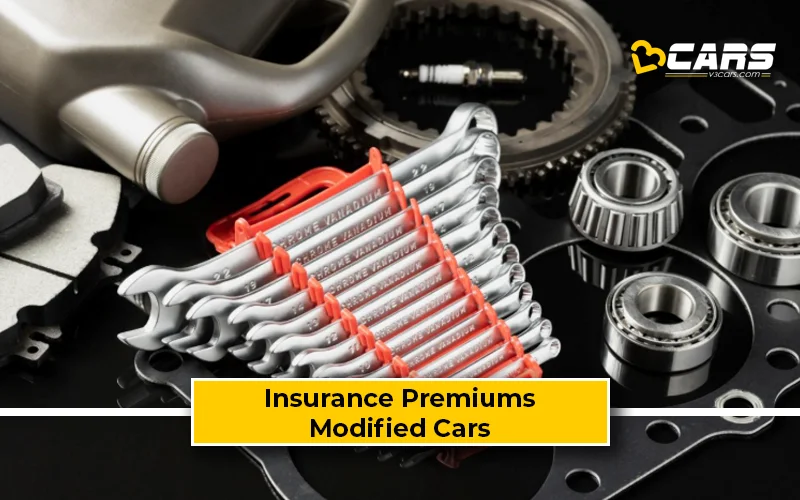Impact Of Modified Car Accessories On Your Insurance Premium
Vehicle owners can modify their cars to enhance performance or aesthetics, creating a personalised, improved driving experience. However, these modifications not only change your vehicle's appearance and performance but also affect your car insurance premiums.

Insurers perform special assessments for a modified vehicle due to its changes in value, repair costs, risks and other factors. Thus, one must clearly understand the impact of car modifications on insurance premiums before making any changes to their vehicle.
Keep reading to learn how vehicle modifications influence your car insurance premium, IDV, claim settlement and other crucial details.
How Modifications Impact Your Insurance Premium?
Several factors, such as the make, model, mileage, specifications and accessories, affect your car insurance premium. When you opt for a vehicle modification, it also affects the premium and other aspects of a car insurance policy. Here are some of the car modification insurance premium impacts:
Higher Premiums Due To Higher Risk
Modified vehicles are considered risky due to hefty repair or replacement costs or high-performance capabilities. For instance, engine modifications can increase your car's power and high-performance engines have a higher chance of accidents.
On the other hand, when your vehicle is modified with expensive custom parts, they are more prone to theft, which also significantly increases the insurer’s risk.
Increased Car Value Raises IDV
IDV in car insurance refers to the insured declared value. It is the current market price of your car and is the amount that you can claim from the insurer when your vehicle is damaged beyond repair or stolen.
When a car gets modified with premium audio systems, specialised body kits, etc., its market price increases. Thus, the IDV of the vehicle also increases, which raises the insurer's payout and, in turn, the premium.
Imported Or Specialised Parts Raise Repair Costs
Installing imported or customised accessories in your vehicle during modifications can result in increased repair and replacement costs. Thus, the insurance premium for your modified car increases because repairs after an accident require specialised parts or labour, which increases claim settlement amounts.
This leads to higher premiums, as insurance companies cover the anticipated additional repair costs of modified vehicles, which are substantially higher than standard models.
Impact On Claim Settlement
Non-disclosure or improper documentation of modifications can cause claim rejections or partial settlements. Insurers may refuse to honour claims related to modifications if they were not informed at the time of policy purchase or renewal.
Additionally, if a modification increases accident risk, it could affect liability determinations and reduce claim payouts. Transparent communication with insurers is crucial to ensure full claim support for modified vehicle components.
Policy Reassessment
Many insurers require reassessment or a specialised policy when significant modifications are made. Standard policies may not cover all changes, so an updated policy reflecting the vehicle's modified status may be necessary.
This reassessment usually results in revised premiums aligned with the altered risk and value profile, highlighting the importance of updating your insurer promptly after modifications.
Example Scenario
Consider a car owner who installs a turbocharger and custom alloy wheels, boosting performance and aesthetics. Such modifications now make the vehicle more accident-prone (because of superior acceleration) and more valuable (because of expensive alloy wheels). These changes result in higher premiums during the policy purchase or renewal. Failure to disclose these changes could lead to denied claims following an accident or theft involving the modified parts.
Types Of Modifications That Affect Your Car Insurance Premium
Here are some of the vehicle modifications that can increase your car insurance premium:
Performance Enhancements
Vehicle owners often modify their cars to improve their performance. This includes modifications of the air filter, brakes, engine, exhaust system, suspension, etc. Changes in these components affect your car’s performance, thereby increasing the risks of accidents.
Thus, your vehicle becomes riskier for the insurer, as it involves higher insurance claims. Here are some of the performance enhancement modifications that can affect your insurance premium:
- Nitrous Injection Kit: Nitrous kits can greatly increase engine speed, but are often illegal on public roads and can void insurance if not disclosed to your provider.
- Turbochargers and Superchargers: These boost engine power and acceleration, making the car faster, but also increase accident risk and insurance premiums due to higher performance.
- ECU Remapping: Reprogramming the ECU unlocks more engine power. It can stress engine parts, change risk factors and push up insurance costs if not reported.
- Brake Modifications: Upgrading brakes can improve stopping power, but unsafe or non-standard changes may impact vehicle safety and hike insurance prices.
- Suspension Upgrades: Custom suspension setups enhance handling but may affect stability and increase insurance costs, especially if safety is compromised.
Aesthetic Or Cosmetic Modifications
You can enhance your vehicle's aesthetics by modifying its features. This includes changing your car's colour, adding carbon fibre components, replacing a few engine parts and changing the headlights and taillights.
All these make your car look more attractive, but also increase the risks of theft. Thus, insurance companies can charge higher premiums because there is a higher risk of claims if the car or its parts are stolen for such high-value upgrades.
Safety And Security Upgrades
Installing advanced safety features like anti-lock brakes, parking sensors, GPS tracking and alarm systems can reduce insurance premiums in some cases. These modifications reduce accident and theft risks, leading insurers to offer discounts or lower car insurance rates for safer vehicles.
Structural Or Chassis Modifications
Changes such as roll cages, reinforced bumpers, or chassis lifts can affect the vehicle's safety and driving dynamics. Structural modifications may increase premiums due to repair complexity or increased accident risk, while safety-related upgrades may decrease costs if they enhance protection.
Modifying car accessories influences your insurance premium primarily by increasing risk, vehicle value and repair costs. Performance and aesthetic changes generally raise premiums, while safety and security upgrades can sometimes lower them.
Always disclose any modifications to your insurer promptly to ensure proper coverage and support for your claim. By understanding these impacts, you can better balance personalisation with insurance affordability and protection.
Also Read: Car Colour Selection Guide Based On Safety, Climate, Resale, Trend
Disclaimer: The views, opinions or facts expressed in this article are solely those of the guest author or contributor. These opinions do not represent those of V3Cars and/or those of V3Cars’ representatives or authors.


0 Comments